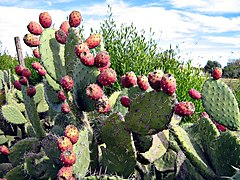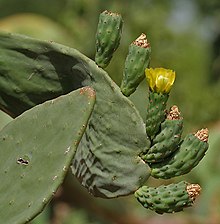Opuntia ficus-indica
| Opuntia ficus-indica | |
|---|---|

| |
| Scientific classification | |
| Kingdom: | |
| Division: | |
| Class: | |
| Order: | |
| Family: | |
| Genus: | |
| Subgenus: | Opuntia
|
| Species: | O. ficus-indica
|
| Binomial name | |
| Opuntia ficus-indica | |
| Synonyms | |
|
Opuntia vulgaris | |


Opuntia ficus-indica (Indian Fig Opuntia) is a species of cactus and a long-domesticated crop plant important in agricultural economies throughout arid and semiarid parts of the world. Indian Fig Opuntia is grown primarily as a fruit crop, but also for the vegetable nopales and other uses. Most culinary references to the "prickly pear" are referring to this species. The name "tuna" is also used for the fruit of this cactus, and for Opuntia in general (according to Alexander von Humboldt, it was a word of Haitian origin taken into the Spanish language around 1500).

Cacti are good crops for dry areas because they efficiently convert water into biomass. Opuntia ficus-indica, as the most widespread of the long-domesticated cactuses, is as economically important as corn and tequila agave in Mexico today. Because Opuntia species hybridize easily (much like oaks), the wild origin of Opuntia ficus-indica (or even whether it has a single origin) is hard to be certain about, but Opuntia was eaten by humans at least 9000 years before the present.[1]
Uses

The most commercially valuable use for Opuntia ficus-indica today is for the large, sweet fruits, called tunas. Areas with significant tuna-growing cultivation include Mexico, Sicily, Algeria, Chile, Brazil, and northern Africa, as well as in Eritrea and Ethiopia where the fruit is called beles (Ge'ez: በለስ).[2]
In Sicily where the Prickly Pear Fruit is known as Fico'dinnia, the cactus grows wild and cultivated to heights of 12-16'. The fruits flower in three distinct colors, White, Yellow and Red. They first appear in early May through the early summer and ripen from August through October. The fruits are typically eaten, minus the thick outer skin, after chilling in a refrigerator for a few hours. They have a taste similar to a juicy extra sweet watermelon, very refreshing on a hot summer or fall day. The bright red/purple, or white/yellowish flesh contains many tiny hard seeds that are usually swallowed, but should be avoided by those who have GI problems with seeds.
Jams and jellies are produced from the fruit, which resemble strawberries and figs in color and flavor.
In the center of Sicily, in the Provence of "Enna", in a small village named "Gagliano Castelferrata", a Prickly Pear flavored liqueur is produced called "Ficodi", flavored somewhat like a medicinal/aperetif.
In the early 1900s, in the United States the Prickly Pear fruit was imported from Sicily and other Mediterranean countries to satisfy the growing population of immigrants arriving from Italy (Sicily)and Greece. The fruit lost its popularity during the mid 1950's and has become increasing in popularity recently in the late 1990s until today, due to the influx of Mexican immigrants.
Recently the cattle industry of the Southwest United States has begun to cultivate Opuntia ficus-indica as a fresh source of feed for cattle. The cactus is grown both as a feed source and a boundary fence. Cattle avoid the sharp spines of the cactus and do not stray from an enclosed area of Opuntia ficus-indica. The nutrition available in the cactus pads, which is what the cows feed on, far surpasses that found in corn and other cattle feed. In addition to the food value, the moisture content virtually eliminates watering the cattle and the human effort in achieving that chore.
The cultivating of cactus requires only that it be planted and left to grow on its own, without fertilizer or watering. It is best grown on land useless for growing corn and other cattle feed stock. After a year or two, the pads are ready to eat and the fruit is ready to harvest if so desired. After each feeding the cactus is left to grow another meal which happens quite quickly in the desert lands of the Southwest. The cows can be moved to another cactus feeding area. The only effort to fed the cattle is to walk through the selected cactus feeding area with a propane backpack and totch. The torch burns the pads, slightly grilling the cactus pads and burning off the spines, then the cattle can feed without getting stuck with the cactus spines. The cows become accustomed to hearing the roar of the propane torch, which acts like a dinner bell for them.
Mexican and other southwestern residents eat the young cactus pads,(nopales) usually picked before the spines harden. They are sliced into strips skinned or unskinned, and fried with eggs and jalapeños, served as a breakfast treat. They have a texture and flavor like string beans.
Also, the cladodes are eaten as nopales. countries Other uses include as an ingredient in adobe (to bind and waterproof).[3]
Opuntia ficus-indica is cultivated (as well as other species in Opuntia and Nopalea) to serve as a host plant for cochineal insects, which produce desirable red and purple dyes. This practice dates from pre-Columbian times.[4]
It is used to make Tungi Spirit on the island of Saint Helena.
O. ficus-indica has various medicinal uses[5] - including use as a hangover cure (see source at bottom of page). Recently, extracts for the cactus pear fruit has shown to possess antioxidative properties and can cause reduction of DNA damage in human peripheral lymphocytes. This extract has become a potential source of raw material for pharmaceutical and functional food industries. [6]
The shoots of O. ficus-indica have been shown to contain at least some mescaline.[7]
Biogeography
Recent DNA analysis indicates that O. ficus-indica was domesticated from Opuntia species which are native to central Mexico. The Codex Mendoza, and other early sources, show Opuntia cladodes as well as cochineal dye (which needs cultivated Opuntia) in Aztec tribute rolls. The plant spread to many parts of the Americas in pre-Columbian times, and since Columbus, have spread to many parts of the world, especially the Mediterranean where they have become naturalized (and in fact were believed to be native by many). This spread was facilitated by the carrying of nopales on ships to prevent scurvy.[8]
Sources
- Anderson, E. F. 2001. The cactus family. Timber Press, Portland, Oregon, USA.
- Barclay, L. 2004 Herb Helps Alcohol Hangover. Medscape Medical news
- Benson, L. H. 1982. The cacti of the United States and Canada. Stanford University Press, Stanford, California, USA.
- Donkin, R. 1977. Spanish red: an ethnogeographical study of cochineal and the Opuntia cactus. Transactions of the American Philosophical Society 67: 1–77.
- Griffith, M. P. 2004. The origins of an important cactus crop, Opuntia ficus-indica (Cactaceae): New molecular evidence. American Journal of Botany 91: 1915-1921.
- Kiesling, R. 1998. Origen, domesticación y distribución de Opuntia ficus-indica. Journal of the Professional Association for Cactus Development 3. Available online.
References
- ^ Griffith, 2004
- ^ "Beles" in Encyclopaedia Aethiopica: A-C(Wiesbaden:Harrassowitz Verlag, 2003).
- ^ Griffith, 2004
- ^ Griffith, 2004
- ^ Griffith, 2004
- ^ NALIN SIRIWARDHANA, FEREIDOON SHAHIDI, YOU-JIN JEON (December 2006). "Potential Antioxidative Effects Of Cactus Pear Fruit (Opuntia Ficus-Indica) Extract On Radical Scavenging And Dna Damage Reduction In Human Peripheral Lymphocytes" (abstract). Journal of Food Lipids. 13 (4): 445–458. doi:10.1111/j.1745-4522.2006.00065.x.
{{cite journal}}: CS1 maint: multiple names: authors list (link) CS1 maint: year (link) - ^ Opuntia ficus-indica (Dr. Duke's Database)
- ^ Griffith, 2004
